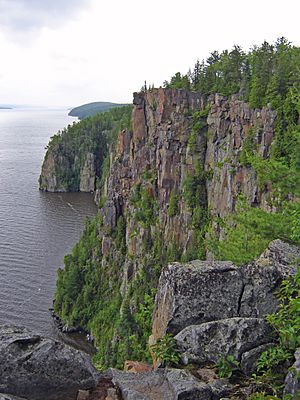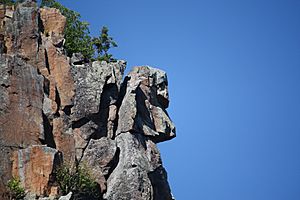Devil's Rock facts for kids
Devil's Rock is a huge, tall cliff made of granite. It's located about 5 kilometers (3 miles) south of Temiskaming Shores, Ontario, Canada. These amazing cliffs rise 300 feet (91 meters) above Lake Timiskaming. What's even cooler is that they go almost as deep underwater as they are tall above it! This means the whole cliff face is about 600 feet (183 meters) high. It's also known as Devils Rock and Mani-doo Aja-bikong.
Contents
Exploring the History of Devil's Rock
Ancient Stories and Name Changes
Devil's Rock is on the traditional lands of the Anishinaabe people, a First Nations group. Long ago, the cliffs were called "Manidoo-Wabikong," which means "Manitou rock." It was a very special and sacred place where people would leave offerings like tobacco.
Later, missionaries changed the name of some sacred places, including Manidoo-Wabikong. They wanted to encourage Christianity among Indigenous communities. So, they renamed it "Devil's Rock" to make it sound like a place of evil spirits.
Silver Mining and Hidden Tunnels
In the early 1900s, a geologist named Dr. Robert Bell thought there might be silver at Devil's Rock. But he couldn't find any himself. Then, during the Cobalt silver rush nearby, a famous lacrosse player named Matthew Murphy found the first silver deposits here.
From 1903 to 1912, Murphy hired miners to dig for silver along the cliffs. Instead of digging shafts from the top, they dug tunnels right into the cliffs from the water. These tunnels helped them reach the silver deep inside. Today, you can still explore some of these old mining tunnels! The silver mines made Matt Murphy very rich, and he used some of his money to build local sports places, like ice rinks.
Famous Visitors and Climbers
In 1929, a mountaineer and occultist named Aleister Crowley visited Devil's Rock. Miners told him about the cliffs, and he tried to climb a part called the "Finger of God." This climbing route is now known as "Samson."
For many years, the steamship Meteor was the only passenger boat on Lake Temiskaming. It was very popular for sightseeing trips. People would take the boat to see beautiful landmarks like Devil's Rock.
Modern Recognition and Trails
Today, Devil's Rock is a popular spot for outdoor activities. In 2010, the Temiskaming Loop was created. This is a motorcycle touring route that encourages people to visit local attractions, including Devil's Rock.
The area has also been named an "Area of Natural & Scientific Interest." There are plans to make it a special "geosite" as part of the Temiskaming Rift Valley Aspiring Geopark.
The Geology of Devil's Rock
Devil's Rock is made of a type of rock called quartz diabase. It's part of the Nipissing sills, which are large sheets of rock formed deep underground. The rock that makes up these cliffs was created by volcanic activity about 2.2 billion years ago! This was during a very ancient time called the Archean eon.
Wildlife and Nature at Devil's Rock
Devil's Rock is in a special area called an ecotone. This is where two different types of forests meet: the boreal forest and the Great Lakes-St. Lawrence forest.
At the top of the cliffs, the plants are often small and stunted. You can find lots of blueberry bushes and balsam fir trees. Sometimes, you might see Eastern spruce budworms eating the fir trees.
Many birds live around Devil's Rock. Peregrine falcons, which are fast hunters, are often seen here. Other birds include American yellow warblers, Nashville warblers, and Chestnut-sided warblers.
Fun Activities at Devil's Rock
Viewing from the Water
You can easily see the cliffs of Devil's Rock from Lake Timiskaming. It's a great view if you're on a boat! There are five old mining tunnels that you can enter from the water. Just remember to bring a flashlight if you want to explore them safely.
Hiking Trails and Lookouts
There are two main hiking trails to reach the top of Devil's Rock.
- The shorter trail is about 2 kilometers (1.2 miles) long and mostly flat. You can start it from a roadside spot along Highway 567. This trail is good all year round, even for snowshoes in winter.
- The longer trail is about 3 kilometers (1.9 miles) long. It starts at the Bucke Park Campground. This trail has steeper parts, which can make it a bit harder in winter.
Many smaller paths lead to amazing viewing spots along the clifftops.
Rock Climbing Adventures
Rock climbing is possible at Devil's Rock, but it's not very common. There are special bolts in the cliff face to help climbers. People have been climbing here since at least 1929. There are eleven named climbing routes, with cool names like "The Awe Inspiring Rites" and "Bombay Sapphire."
Important Safety Tips
There are not many fences or supervisors at Devil's Rock to stop hikers from falling. Signs along the trails warn you when you get close to the edge. A large white cross is also placed at the edge to remind visitors that a fall from the 300-foot (91-meter) height of Devil's Rock can be deadly. Always be careful and stay away from the edge!
Myths and Legends of Devil's Rock
Anishinaabe Legends
Before Europeans arrived, the Anishinaabeg people called the cliffs "Manidoo-Wabikong," meaning "Manitou rock." It was a sacred place where they left offerings of tobacco. An old account from 1879 describes how Native crews would put tobacco in the water near the rocks. They believed it would please the "water sprite" and ensure a safe journey.
Some stories say that the people of Timiskaming First Nation once called the cliffs "Frog Lake." This was because a giant frog was said to have smashed the rocks, creating the cliffs we see today.
Another Anishinaabe legend tells of tiny creatures called Memequayshowak, or "rock demons," who lived at Devil's Rock. One story says that an Anishinaabe raiding party captured one of these demons and his knife. But another demon escaped into the cliffs and made such loud echoes that the attackers got scared. They threw the dagger back, believing the cliffs held an entrance to the underworld.
French Canadian Folklore
French traders also created new stories about Devil's Rock. They felt tremors around the lake and thought that tapping sounds on their boats were from water sprites. Like the Native people, they would leave tobacco offerings at places like Devil's Rock for safe travel.
Another French-Canadian legend says that the cliffs were formed when the Devil ran away with a girl from the Temiskaming area. But on their honeymoon, the Devil got tired of her and turned her into Devil's Rock!
Modern Urban Legends
A modern urban legend says that if you look at the cliffs from the right angle, they look like the face of the Devil. This is an example of pareidolia, where you see familiar shapes in random patterns.



